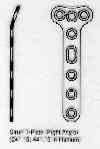- Discussion:
- T plates are designed to be used as a butress plates, esp for lateral or medial tibial plateau frx;
- they are also applied in volar Barton's frx and proximal humerus fractures;
- butress compression:
- these plates can be used to support the cortex of a metaphysis from crumbling or displacing by applying axial compression from a
pre-contoured plate;
- the first screw inserted is always in the oval hole (on the near side of the joint) which causes the plate to move toward the joint,
which effects a compression butress force;
- if two ends of the plate are fixed to bone first and there is a gap between plate and the bone, plate is brought under tension, as
remaining screws are inserted, which risks frx displacement and deformity;
- butress plates must be accurately contoured;
- if a butress plate were to be accidentally placed under tension, it might lead to iatrogenic displacement of fracture;
- by contouring the plate w/ a slight prebend (undercontour), movement of the plate towards the joint (which occurs from eccentric
screw placement) will cause compression of the periarticular fracture fragments;
- Large T Plate Characteristics:
- head of the plate accomodates 6.5 mm cancellous bone screws;
- elongated hole is for loose temporary fixation with a cortex screw;
- distal holes accept 4.5 mm cortex screws;
- thickness 2.0
- width 17 mm
- available w/ 3,4,5,6, & 8 holes in the shaft and 68, 84, 100, 116, & 148 mm in length;
- L butress plates have 4 holes only and are 81 long;
- width shaft T butress plate: 17 mm
- Width shaft buttress plate: 16 mm;
- Lateral Tibial Head Butress Plates:
- designed as buttress plates for fractures of lateral tibial plateau w/ proximal diaphyseal involvement;
- L plate allows more butressing w/o getting in the way of proximal fibula;
- comes in a right and left version;
- DCP holes in the shaft accept 4.5 mm cortex screws;
- round holes in the slightly thinner head accomodate 6.5 mm cancellous bone screws;
- available in 5, 7, and 9 holes in the shaft;
- thickness 3.8 mm



